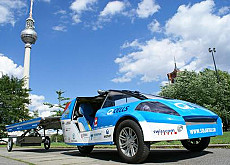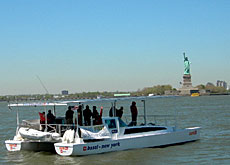“Solar taxi” starts record trip round world

Swiss adventurer Louis Palmer has set off from Lucerne in his "Solartaxi", the first motor vehicle not powered by fossil fuel to attempt to travel around the world.
Palmer’s circumnavigation – which he hopes will highlight the problem of global warming – is set to take around 15 months and cover at least 50,000 km, 50 countries and five continents.
“I got the idea when I was 14,” Palmer told swissinfo, before he set off from outside Lucerne’s culture and convention centre on July 3. “That was the first time I saw a solar-powered car and I thought ‘If it’s possible to drive a solar-powered car around a city, why is it not possible to drive one around the world?'”
Palmer, a travel editor and teacher when not working his way round the world, has already bicycled across five continents and worked as a photographer in Afghanistan.
The motivation for his latest adventure is the global warming crisis.
“I want to show that solutions to global warming exist, and this Solartaxi is just one example to show that if we really want to stop global warming, don’t hesitate – just do it.”
No emissions
At a time when climate change and fuel resources are rarely out of the headlines, Palmer wants to demonstrate that sustainable technologies are already perfectly suited to everyday use and that they can even be used to go around the world.
“I want to make people use solar energy. I want people to realise that they can drive cars with solar energy so there is no need for petrol cars. Petrol cars in my opinion are out.”
The Solartaxi consists of a solar vehicle and trailer with solar cells. The vehicle is powered totally by solar energy: 50 per cent of the energy comes from the solar cells on the trailer; the other 50 per cent is produced and fed into the power grid on the roof of the Swisscom building just outside Bern and accessed via power sockets en route.
The vehicle, which has a maximum speed of 90km/h, thus uses electricity from 100 per cent renewable energy and releases no emissions into the atmosphere.
It is however being accompanied by a conventional vehicle carrying everything needed for a trip around the world.
Room for two
The three-wheeler has space for an additional person and Palmer is using this to pick up fellow travellers along the way. Passengers can also drive, as the steering wheel slides across.
Swiss psychiatrist and balloonist Bertrand Piccard, who intends to fly around the world in his solar plane “Solar Impulse” in 2011, was the Solartaxi’s first fare.
Piccard soon hopped out, but six days after leaving Lucerne – to where the Solartaxi will hopefully return – it pulled into the Swiss embassy in Berlin.
The final route will depend on the invitations the team receives. Palmer is urging people – politicians, scientists or anyone involved in global warming – to contact him, wherever they are in the world.
“I have a rough idea [of the route],” he said. “I want to go from West to East. I want to follow the Silk Road [an interconnected series of ancient trade routes from China to the Mediterranean] across the Middle East and then down to India and then Australia.”
Will he be consulting the global warming “Goracle” himself: ex-vice president Al Gore? “I’ve got to make it to the United States first. Once I’m there I’ll call him and hopefully he’ll talk to me.”
Palmer is delighted by the reaction to his project, which he says has definitely been “Great idea – good luck!” rather than “That’s impossible – you’re crazy!”
“Maybe you have to be slightly crazy, but what choice do you have?” he said. “Do you want to do what everyone else in the world does? I think that’s crazy.”
swissinfo, Thomas Stephens
Switzerland receives about 40,000 billion kilowatt/hours of sunshine annually, or 220 times more than the country’s entire energy requirements.
There are more than 40,000 solar heating systems with a total surface of around 350,000 square metres.
Another 1,800 solar electricity systems are tied to the power grid, and countless others are in private hands, with a total surface of 170,000 square metres.
Altogether they produce 0.3% of the country’s heating requirements and 0.03% of its electricity.
Switzerland has 400 million square metres of roof surfaces that could be used for solar energy.
In 1990 a solar-powered car designed by Biel’s engineering school won the World Solar Challenge across Australia.
In May 2007 the Sun21 boat successfully completed a trans-Atlantic crossing.
In 2009 a 30-metre boat known as Planet solar will try to circumnavigate the globe.
In 2011 Swiss adventurer Bertrand Piccard hopes his Solar Impulse aircraft will fly around the world.
In the Intergovernmental Panel on Climate Change report in February, scientists said it was “very likely” – or more than 90% probable – that global warming was man-made.
The report predicts a “best estimate” that temperatures will rise by 1.8-4°C in the 21st century, within a likely range from 1.1-6.4°C.
The study projects a rise in sea levels of 28-43cm in the 21st century – and said bigger gains could not be ruled out if ice sheets in Antarctica and Greenland thaw.

In compliance with the JTI standards
More: SWI swissinfo.ch certified by the Journalism Trust Initiative












You can find an overview of ongoing debates with our journalists here . Please join us!
If you want to start a conversation about a topic raised in this article or want to report factual errors, email us at english@swissinfo.ch.